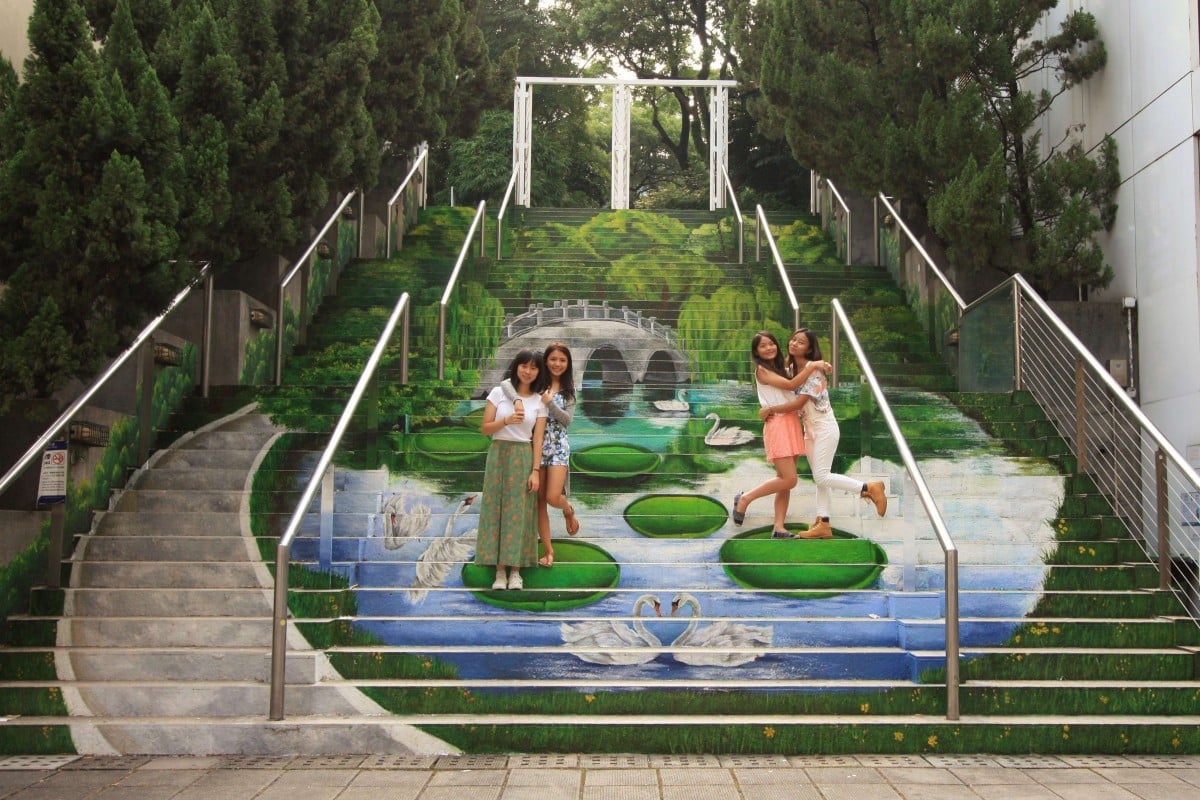
Hong Kong students are taking their love for art out of the studio and into the streets by painting 3D murals on walls across the city – and it’s legal
 From left: Denise Yeung, Terena Wong, Sandy Cheng and K.K. Kum are chasing their artistic dreams
From left: Denise Yeung, Terena Wong, Sandy Cheng and K.K. Kum are chasing their artistic dreamsWhen it comes to go big or go home, four Hong Kong art students are going big. And outdoors. The artists come from Omni Art, the first Hong Kong group specialising in 3D floor painting, wall paintings and other creative projects. Between them they have painted more than 20 3D works on the walls, floors and stairs of schools, community centres and public areas.
Denise Yeung Tsz-ching, Terena Wong Lai-tung, Sandy Cheng Kit-yu and K. K. Kum Ka-wai say they want to make art everywhere, so that people don’t need to go to galleries to appreciate it.
The painters come from different backgrounds. While Denise, Sandy and K.K. study at the Academy of Visual Arts at Hong Kong Baptist University, Terena majors in education of arts at the Hong Kong Institute of Education.
The girls’ teacher at Omni Art, Lam Yuk-fai, brought them together during a Community Art volunteer wall painting workshop that they all attended. He took them to explore murals and 3D paintings in districts like Tsuen Wan, Central, Yau Ma Tei, Tai Po and Tsim Sha Tsui.
“Lam was an innovative artist and designer in the 80s and now he is influential and respected for the development of community art and education,” explains Denise. “He has inspired us a lot.”
Denise, Terena, Sandy and K.K. are all very different individuals, with their own unique styles of painting. But their contrasting personalities is a good thing, as it means they can focus on different things, and generate a wider variety of ideas for their work.
And although they all have different characters, they all have one thing in common – they all enjoy singing while painting.
But a love for singing isn’t all they have in common. They all prefer painting nature scenes, as they believe that in such a fast-paced city, they can provide an alternative way to appreciate the environment.
And their focus changes with each project. For charity projects, they usually place more emphasis on the message. For commercial projects, they try to focus more on the visual aspect of the paintings.
Producing a 3D painting has four stages: paper drafting, marking accurate fixed points, drafting on site and colouring.
First, the painters create sketches on paper to use as a reference tool. Next, due to the large scale of painting a set of stairs, for example, they have to mark fixed points for the on site drafting. To ensure accurate marking and the best effect of painting, one painter stands where a viewer would and gives advice via phone to someone else, who is marking the staircase.
After marking these fixed points, they follow the outline to finish the entire draft.
Lastly, they colour the draft in while making sure the lines are well connected between the stairs as they finish the painting.
The completion time for projects depends on the scale of the paintings, but it ranges from a week for the smallest works, for the Hong Kong Cross Harbour Race 2015, for example, to one and a half months for their largest project, a dolphin painting in Tai Po.
The painters face a lot of difficulties.
“The uncontrollable weather can be a problem,” says Terena. Painting in hot weather is a challenge, while rain forces them to stop work altogether.
Although they find painting challenging, they still believe it is rewarding. The biggest reward for them is seeing 3D art get greater recognition.
“At first, people thought we were painting illegally, and they even called the Highway Department on us. But as we kept coming back, people started to recognise our work. Then they gave us food, drinks and towels while we were painting,” says Denise, adding that praise for their work on social media has motivated them.
And painting in public places is never dull. K.K. remembers having to deal with a dog peeing on the stairs while they were working. “Luckily it didn’t pee on our work, but we had to clean our brushes!” K.K. laughs.
Denise says art isn’t just about appreciation; it has a lot of useful purposes too, for both business and community arts. This means art can be a valuable asset for anyone, no matter what industry they hope to go into. K.K. adds that being an artist isn’t restrictive, so there is always the option to find other, related work if it doesn’t lead to success.
They advise anyone who is confused about their future to do what they love – if 3D outdoor art is a success anything is possible.